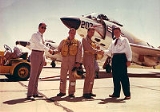
F3H Demon
Encyclopedia
The McDonnell
F3H Demon was a subsonic swept-wing United States Navy
carrier-based
jet
fighter aircraft
. After severe problems with Westinghouse J40
engine that was ultimately abandoned, the successor to the McDonnell F2H Banshee served starting in 1956 redesigned with the J71 engine. Though it lacked sufficient power for supersonic performance, it complemented daylight dogfighters such as the Vought F8U Crusader and Grumman F11F Tiger as an all-weather, missile-armed interceptor until 1964. It was withdrawn before it could serve in the Vietnam when it, and ultimately also the Crusader, was replaced by the extremely successful McDonnell Douglas F-4 Phantom II. McDonnell's Phantom, which was equally capable against ground, fighter and bomber targets, bears a strong family resemblance, as it was conceived as an advanced development of the Demon. The supersonic United States Air Force McDonnell F-101 Voodoo was similar in layout, but was derived from the earlier XF-88 Voodoo, which also influenced the Demon's layout.
Douglas F4D Skyray. The Skyray, with a top speed of 722 mph, would become the Navy's first fighter to fly supersonic in level flight, while the Demon would never reach that level of performance. Departing from its tradition of using two engines, the Demon would be McDonnell's only single-engine carrier-based fighter, adopting under some Navy pressure to use the Westinghouse J40
engine. That engine was being promoted by the Navy for its next generation of aircraft, and was to have thrust of over 11,000 lbf (49 kN)—three times that of the engines in the F2H Banshee. It was the first swept-wing design produced by McDonnell and among the first U.S. aircraft to have missile armament.
The Navy desperately needed a high performance fighter to meet the challenge of the swept-wing MiG-15
encountered over Korea. Production of the F3H-1N was hastily ordered even before the first flight of the XF3H-1 prototype on 7 August 1951 by test pilot Robert Edholm. The first test flights of the operational design did not occur until January 1953, when the Korean War
was winding down. The engine was a major disappointment, producing only half of the expected power. Worse, it was temperamental and unreliable. Of 35 F3H-1N aircraft flown with the J40 engine, eight were involved in major accidents. The J40-engined aircraft were grounded and a new engine was sought. The proposed F3H-1P reconnaissance version was never built.
The best alternative was the Allison J71
engine which was also used in the Douglas B-66 Destroyer. Subsequent F3Hs with this engine were designated the F3H-2N. Use of this engine required an enlarged wing and redesigned fuselage. In service, the J71 proved problematic, providing insufficient power for an aircraft of the Demon's size. The engine also suffered from frequent flameout
s and compressor stall
s. The first Demon with a J71 flew in October 1954. Another significant problem was the reliability of the ejection seats: initial versions were found to be unreliable and were eventually replaced with Martin-Baker
ejection seats that were becoming the standard Navy seat of choice due to their higher performance at low altitude and better reliability.
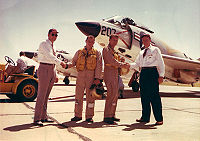 Despite the problems, the Navy ordered 239 F3H-2s, and the first were deployed in March 1956. 519 Demons were built up to the end of production in November 1959. It was not the Navy's first all-weather interceptor
Despite the problems, the Navy ordered 239 F3H-2s, and the first were deployed in March 1956. 519 Demons were built up to the end of production in November 1959. It was not the Navy's first all-weather interceptor
with radar (the AN/APG-51 air interception set was used first on the F2H-4 Banshee). The F3H-2 Demon had the AN/APG-51A, later upgraded to the 51-B version with a tunable magnetron then on to 51-C with better counter-measures in the receiver.
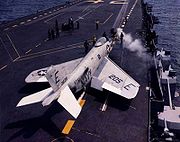 The F3H-2N's standard armament was four 20 mm (.79 in) Colt Mk 12 cannon
The F3H-2N's standard armament was four 20 mm (.79 in) Colt Mk 12 cannon
s. In later years, the upper two cannons were often omitted to save weight. Later models, redesignated F3H-2M, were equipped to fire the Raytheon AAM-N-2 Sparrow
and later the Sidewinder
air-to-air missile
s. Deployed aircraft carried both types of missiles, the Sparrow on the inboard rails and the Sidewinder outboard. Cannons were not used in carrier air defense applications, but they were installed and armed when situations (such as the Cuban Missile Crisis
) dictated, and where the aircraft might be deployed against surface targets.
A reconnaissance
version, the F3H-2P, was proposed, but never built.
It remained the Navy's front-line fighter until 1962, when it was succeeded by the F-4 Phantom II
(which was a development of a proposed "Super Demon", a larger and much heavier version of the F3H). Developed during the Korean War to counter the MiG-15, it did not claim any aerial victories with missiles or dogfights, although it flew over Lebanon
and Quemoy in 1958.
In 1962, the F3H was redesignated F-3. The F3H-2N became the F-3C, while the F3H-2M became MF-3B and the F3H-2 simply F-3B.
The last Demon-equipped squadron, VF-161 'Chargers', traded their F-3s for F-4 Phantom IIs in September 1964.
Due to excellent visibility from the cockpit, the Demon earned the nickname "The Chair". Demon pilots were known colloquially as "Demon Drivers" and those who worked on the aircraft were known as "Demon Doctors". The unfavorable power-to-weight ratio gave rise to the less flattering nickname "lead sled," sometimes shortened to "sled".
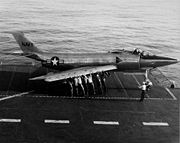 XF3H-1
XF3H-1
F3H-1N
F3H-1P
F3H-2N
F3H-2M
F3H-2
F3H-2P
F3H-3
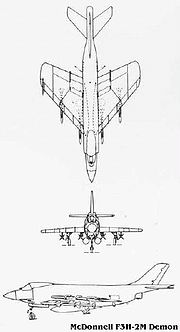
McDonnell Aircraft
The McDonnell Aircraft Corporation was an American aerospace manufacturer based in St. Louis, Missouri. The company was founded on July 16, 1939 by James Smith McDonnell, and was best known for its military fighters, including the F-4 Phantom II, and manned spacecraft including the Mercury capsule...
F3H Demon was a subsonic swept-wing United States Navy
United States Navy
The United States Navy is the naval warfare service branch of the United States Armed Forces and one of the seven uniformed services of the United States. The U.S. Navy is the largest in the world; its battle fleet tonnage is greater than that of the next 13 largest navies combined. The U.S...
carrier-based
Aircraft carrier
An aircraft carrier is a warship designed with a primary mission of deploying and recovering aircraft, acting as a seagoing airbase. Aircraft carriers thus allow a naval force to project air power worldwide without having to depend on local bases for staging aircraft operations...
jet
Jet engine
A jet engine is a reaction engine that discharges a fast moving jet to generate thrust by jet propulsion and in accordance with Newton's laws of motion. This broad definition of jet engines includes turbojets, turbofans, rockets, ramjets, pulse jets...
fighter aircraft
Fighter aircraft
A fighter aircraft is a military aircraft designed primarily for air-to-air combat with other aircraft, as opposed to a bomber, which is designed primarily to attack ground targets...
. After severe problems with Westinghouse J40
Westinghouse J40
|-References:...
engine that was ultimately abandoned, the successor to the McDonnell F2H Banshee served starting in 1956 redesigned with the J71 engine. Though it lacked sufficient power for supersonic performance, it complemented daylight dogfighters such as the Vought F8U Crusader and Grumman F11F Tiger as an all-weather, missile-armed interceptor until 1964. It was withdrawn before it could serve in the Vietnam when it, and ultimately also the Crusader, was replaced by the extremely successful McDonnell Douglas F-4 Phantom II. McDonnell's Phantom, which was equally capable against ground, fighter and bomber targets, bears a strong family resemblance, as it was conceived as an advanced development of the Demon. The supersonic United States Air Force McDonnell F-101 Voodoo was similar in layout, but was derived from the earlier XF-88 Voodoo, which also influenced the Demon's layout.
Development
Development work began in 1949, using a swept wing from the start rather than adapting a straight-winged design as was done with the Grumman F9F Panther. A competing contract was also awarded for the delta wingDelta wing
The delta wing is a wing planform in the form of a triangle. It is named for its similarity in shape to the Greek uppercase letter delta .-Delta-shaped stabilizers:...
Douglas F4D Skyray. The Skyray, with a top speed of 722 mph, would become the Navy's first fighter to fly supersonic in level flight, while the Demon would never reach that level of performance. Departing from its tradition of using two engines, the Demon would be McDonnell's only single-engine carrier-based fighter, adopting under some Navy pressure to use the Westinghouse J40
Westinghouse J40
|-References:...
engine. That engine was being promoted by the Navy for its next generation of aircraft, and was to have thrust of over 11,000 lbf (49 kN)—three times that of the engines in the F2H Banshee. It was the first swept-wing design produced by McDonnell and among the first U.S. aircraft to have missile armament.
The Navy desperately needed a high performance fighter to meet the challenge of the swept-wing MiG-15
Mikoyan-Gurevich MiG-15
The Mikoyan-Gurevich MiG-15 was a jet fighter developed for the USSR by Artem Mikoyan and Mikhail Gurevich. The MiG-15 was one of the first successful swept-wing jet fighters, and it achieved fame in the skies over Korea, where early in the war, it outclassed all straight-winged enemy fighters in...
encountered over Korea. Production of the F3H-1N was hastily ordered even before the first flight of the XF3H-1 prototype on 7 August 1951 by test pilot Robert Edholm. The first test flights of the operational design did not occur until January 1953, when the Korean War
Korean War
The Korean War was a conventional war between South Korea, supported by the United Nations, and North Korea, supported by the People's Republic of China , with military material aid from the Soviet Union...
was winding down. The engine was a major disappointment, producing only half of the expected power. Worse, it was temperamental and unreliable. Of 35 F3H-1N aircraft flown with the J40 engine, eight were involved in major accidents. The J40-engined aircraft were grounded and a new engine was sought. The proposed F3H-1P reconnaissance version was never built.
The best alternative was the Allison J71
Allison J71
|-External links:*...
engine which was also used in the Douglas B-66 Destroyer. Subsequent F3Hs with this engine were designated the F3H-2N. Use of this engine required an enlarged wing and redesigned fuselage. In service, the J71 proved problematic, providing insufficient power for an aircraft of the Demon's size. The engine also suffered from frequent flameout
Flameout
A flameout refers to the failure of a jet engine caused by the extinction of the flame in the combustion chamber. It can be caused by a number of factors, including fuel exhaustion; compressor stall; insufficient oxygen supply; foreign object damage ; severe inclement weather; and mechanical...
s and compressor stall
Compressor stall
A compressor stall is a situation of abnormal airflow resulting from a stall of the aerofoils within the compressor of a jet engine. Stall is found in dynamic compressors, particularly axial compressors, as used in jet engines and turbochargers for reciprocating engines.Compressor stalls result in...
s. The first Demon with a J71 flew in October 1954. Another significant problem was the reliability of the ejection seats: initial versions were found to be unreliable and were eventually replaced with Martin-Baker
Martin-Baker
Martin-Baker Aircraft Co. Ltd. is a manufacturer of ejection seats and safety related equipment for aviation. The company origins were as an aircraft manufacturer before becoming a pioneer in the field of ejection seats...
ejection seats that were becoming the standard Navy seat of choice due to their higher performance at low altitude and better reliability.

Interceptor aircraft
An interceptor aircraft is a type of fighter aircraft designed specifically to prevent missions of enemy aircraft, particularly bombers and reconnaissance aircraft. Interceptors generally rely on high speed and powerful armament in order to complete their mission as quickly as possible and set up...
with radar (the AN/APG-51 air interception set was used first on the F2H-4 Banshee). The F3H-2 Demon had the AN/APG-51A, later upgraded to the 51-B version with a tunable magnetron then on to 51-C with better counter-measures in the receiver.

Colt Mk 12 cannon
The Colt-Browning Mk 12 was a 20 mm cannon widely used by the United States Navy after World War II.-Development:The Mk 12 was an advanced derivative of the wartime Hispano HS 404 that had been used on a variety of American and British fighter aircraft during World War II...
s. In later years, the upper two cannons were often omitted to save weight. Later models, redesignated F3H-2M, were equipped to fire the Raytheon AAM-N-2 Sparrow
AIM-7 Sparrow
The AIM-7 Sparrow is an American, medium-range semi-active radar homing air-to-air missile operated by the United States Air Force, United States Navy and United States Marine Corps, as well as various allied air forces and navies. Sparrow and its derivatives were the West's principal beyond visual...
and later the Sidewinder
AIM-9 Sidewinder
The AIM-9 Sidewinder is a heat-seeking, short-range, air-to-air missile carried mostly by fighter aircraft and recently, certain gunship helicopters. The missile entered service with United States Air Force in the early 1950s, and variants and upgrades remain in active service with many air forces...
air-to-air missile
Air-to-air missile
An air-to-air missile is a missile fired from an aircraft for the purpose of destroying another aircraft. AAMs are typically powered by one or more rocket motors, usually solid fuelled but sometimes liquid fuelled...
s. Deployed aircraft carried both types of missiles, the Sparrow on the inboard rails and the Sidewinder outboard. Cannons were not used in carrier air defense applications, but they were installed and armed when situations (such as the Cuban Missile Crisis
Cuban Missile Crisis
The Cuban Missile Crisis was a confrontation among the Soviet Union, Cuba and the United States in October 1962, during the Cold War...
) dictated, and where the aircraft might be deployed against surface targets.
A reconnaissance
Reconnaissance
Reconnaissance is the military term for exploring beyond the area occupied by friendly forces to gain information about enemy forces or features of the environment....
version, the F3H-2P, was proposed, but never built.
It remained the Navy's front-line fighter until 1962, when it was succeeded by the F-4 Phantom II
F-4 Phantom II
The McDonnell Douglas F-4 Phantom II is a tandem two-seat, twin-engined, all-weather, long-range supersonic jet interceptor fighter/fighter-bomber originally developed for the United States Navy by McDonnell Aircraft. It first entered service in 1960 with the U.S. Navy. Proving highly adaptable,...
(which was a development of a proposed "Super Demon", a larger and much heavier version of the F3H). Developed during the Korean War to counter the MiG-15, it did not claim any aerial victories with missiles or dogfights, although it flew over Lebanon
Lebanon
Lebanon , officially the Republic of LebanonRepublic of Lebanon is the most common term used by Lebanese government agencies. The term Lebanese Republic, a literal translation of the official Arabic and French names that is not used in today's world. Arabic is the most common language spoken among...
and Quemoy in 1958.
In 1962, the F3H was redesignated F-3. The F3H-2N became the F-3C, while the F3H-2M became MF-3B and the F3H-2 simply F-3B.
The last Demon-equipped squadron, VF-161 'Chargers', traded their F-3s for F-4 Phantom IIs in September 1964.
Due to excellent visibility from the cockpit, the Demon earned the nickname "The Chair". Demon pilots were known colloquially as "Demon Drivers" and those who worked on the aircraft were known as "Demon Doctors". The unfavorable power-to-weight ratio gave rise to the less flattering nickname "lead sled," sometimes shortened to "sled".
Variants

- Prototype single-seat clear-weather interceptor fighter. Powered by 6500 lbf (28.9 kN) (9200 lbf (40.9 kN) with afterburner) Westinghouse XJ40Westinghouse J40|-References:...
-WE-6 engine. Two built.
F3H-1N
- Initial production version. Single-seat all-weather fighter version, powered by 7200 lbf (32 kN) (10900 lbf (48.5 kN) with afterburner) J40-WE-22 engine. 58 built.
F3H-1P
- Proposed reconnaissance version of F3H-1. Never built.
F3H-2N
- All-weather fighter powered by 9500 lbf (42.3 kN) (14250 lbf (63.4 kN) Allison J71Allison J71|-External links:*...
-A-2 engine and equipped to carry AIM-9 SidewinderAIM-9 SidewinderThe AIM-9 Sidewinder is a heat-seeking, short-range, air-to-air missile carried mostly by fighter aircraft and recently, certain gunship helicopters. The missile entered service with United States Air Force in the early 1950s, and variants and upgrades remain in active service with many air forces...
air-to-air missiles. 239 built. Redesignated F-3C in 1962.
F3H-2M
- Derivative of F3H-2N armed with four AIM-7 Sparrow air-to-air missiles. 80 built. Redesignated MF-3B in 1962.
F3H-2
- Single-seat strike fighter version, retaining Sidewinder and Sparrow capability of -2N and -2M and adding payload of 6,000 lb (2,730 kg) bombs or rockets. 239 built. Resignated F-3B in 1962.
F3H-2P
- Proposed photo-reconnaissance version of -2. Unbuilt.
F3H-3
- Proposed version with more powerful General Electric J73General Electric J73|-See also:-External links:...
engine. Unbuilt.
Specifications (F3H-2)


